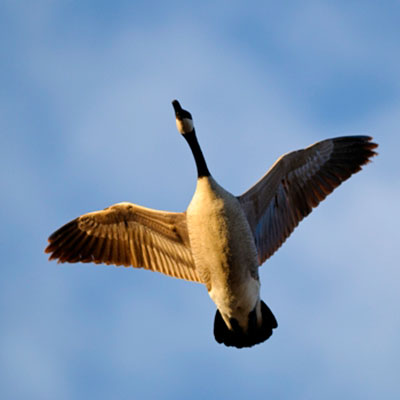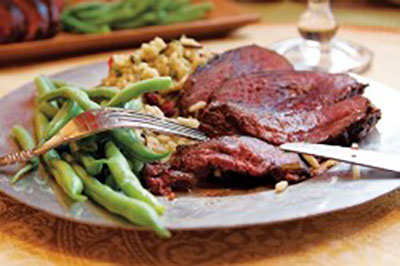Tips From The Pro’s
How High Is Too High?
By BC Maximas

“This is as close as their going to get, it’s now or never…Take Em!” That is a phrase that is heard all too often in the field these days. Weather it is because waterfowl are getting smarter each year or that the hunting pressure is getting higher; many hunters are having trouble getting the birds to decoy in close enough for a clean kill and are resorting to shooting at birds that are just too far away.
At some point the ethics of hunting has to come into play. Talk to any serious bow hunter and you will find out what dedication to the sport of hunting truly is. It is not uncommon for an avid bow hunter to spend weeks or even months in a tree to get one chance at a trophy buck.
He will spend countless hours target practicing in preparation for that one shot. In many instances when that one opportunity comes along, the shot is just too far away for a clean kill and he elects to pass out of respect for the animal. I have never heard a bow hunter say “I had that big 12 pointer at about 75 yards and he wasn’t getting any closer so I let a couple arrows fly just to see what would happen”. However duck and goose hunters seem to take pride in telling their friends that the bird they shot had to be at least 80 yards up there! And unfortunately when one stray pellet drops a bird at a great distance, now that hunter seems to feel that distance is a killable shot. They fail to take into account that although one in a hundred shots at that range may kill a bird, there are dozens and dozens more birds that are hit but do not go down right away and end up suffering and dying weeks later in a slough far away. Weather it is a trophy buck or a green wing teal, our natural resources need to be treated as a treasure and not a video game.
Over the many years of guiding novice hunters, as well as spending time in the field with seasoned outfitters, I have seen and heard it all. One of the most common questions that gets asked before a hunt is: what sized shot do I need? Inside of 30 yards most any size waterfowl load will kill a bird if it is in the pattern. Recently though, the craze in the industry is for the use of after market, tight patterned choke tubes and 31/2” inch shells. The ammunition manufactures are making claims of being able to take birds at longer and longer distances with this new cutting edge technology. However tight choke tubes are not as effective for shots taken under 30 yards. Have we not gotten away the true sport of hunting? At the basic level, the sport should be about matching wits with nature to proficiently harvest game for the consumption of its meat. Sure it is rewarding to watch a big Canada goose fold clean at 40 yards and drop stone cold to the ground. There is always a personal satisfaction that comes from a clean kill that you personally made. However for me, it is just as rewarding having a flock of Canada geese fly by so close you can feel their wing beats over your blind. Or having the birds almost touch down in the decoys before taking the shot. It is also much more productive taking birds in the 20 – 30 yard range. If on a certain day the birds are flaring off of your decoys at 60 yards, instead of taking a bad shot and hoping that you might get lucky and break a wing, get up and make corrections to the spread or camo your blind better so they next flock will come in close enough for a clean kill. It is very unrewarding for the ethical hunter to watch a bird sail away and even drop dead a mile out in some marsh, where there is no way to ever retrieve the bird.
I also hear many hunters say at the end of a hunt that they do not want the birds they shot, especially Canada geese and Snow geese. They just don’t like the taste of the birds. I rarely hear an argument at the end of a pheasant hunt over who is going to take the harvested game home. In fact some hunters are as pompous as to expect their outfitter to dispose of the birds for them! My feeling is if you do not like the taste of the game you are hunting, maybe it is time to start hunting something you do enjoy eating. After all, going back to our ancestors, the reason we are hunters is to put food on the table for our family…right?
To end this article on a positive note, I know there are many, many hardcore waterfowl hunters out there who have the experience and knowledge to get their birds to decoy in close and make a clean kill.

Being a mentor and a roll model to not only a kid but to an inexperienced hunter can be a great thing. Let’s spend time with a young hunter well in advance of bringing them out on their first hunt. Get that new hunter through a gun safety program and then out to a sporting clays range in the “pre-season”. This will give them the confidence that they can make a clean kill. It will also show them what their limitations are. Then teaching that hunter how to set up a decoy spread and when to call the shot is a much more rewarding feeling than taking them out on their first hunt with no knowledge of what is going on and watching that new hunter struggle and miss shot after shot because they really didn’t have a chance to begin with.
For those hunters who are new at the game and do not have a person to teach them how to be successful in the field, booking a hunt with a quality, reputable outfitter can be a much better option then investing a lot of hard earned money on a lot of unnecessary gear and equipment. As always the best advice for anything is; practice, practice, and practice. Join a summer trap and skeet league and become a competent shot. Then learn some great recipes on how to cook the game you are planning to hunt before you even harvest your first bird. Trust me, if you can shoot well and are excited to take your game home, you will most likely be invited back to hunt with any group. And finally treat each bird or animal as if it were a true trophy…it truly is!
Additional Tips From The Pro’s Articles
- Decoying And Calling: The Hard Facts!
- Decoying Canada Geese – Decoying Canada Geese
- Retrievers & Chiropractic – Can An Animal Chiropractor Help?
- Retriever Performance Events And Why You Should Care
- The Scent Control Debate
- Ten Tips For A More Successful Pheasant Hunt
- Wanton Waste Laws – What Do They Mean & Why Do They Exist?
- How To Get Started Bow Hunting
- The Perfect Deer Rifle
- Exercise Induced Collapse (EIC) In Retrievers – Hunters Beware!
- A Guide To Tipping Your Guide
- Are Canada Geese Actually Getting Smarter Each Fall?
- Top 5 Criteria To Look For in A Fishing Report
- How High Is Too High?
- Turkey Hunting Tips And Tactics
- Realistic Expectations For A Quality Guided Spring Snow Goose Hunt
- Conditioning Your Retriever For The Upcoming Season
